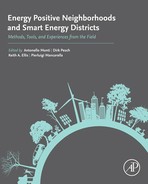Book Description
Energy Positive Neighborhoods and Smart Energy Districts: Methods, Tools, and Experiences from the Field is a comprehensive guide to this highly interdisciplinary topic. Monti et. al’s combined experience make them the most qualified team of editors to explore the processes and tools involved in creating Energy Positive Neighborhoods and Smart Energy Districts in an urban setting. Tools include:
- A complete simulation library to quickly support the implementation of a model of the scenario
- A set of possible approaches to neighborhood energy optimization
- An open, extensible information model for neighbourhood asset description
The structure of this book offers different reading paths to appeal to the very varied audience it addresses. It describes the process of adaption and the challenges faced by the decision makers, and also how simulation, optimisation, ICT approaches and business models are combined in a holistic and pragmatic way. It also offers possible business models and a means to quantify them to complete the development process. This book is suitable for students on muti-disciplinary energy engineering courses, energy practitioners, ICT vendors aiming to develop new services to target the building industry, and decision makers aiming to structure an urban renovation program.
- Delivers a significant amount of exclusive knowledge on the topics of energy positive neighborhoods and smart energy districts
- Allows readers to grasp the complexity of this interdisciplinary topic by providing access to well-structured processes and tools
- Includes real life examples of the transformation of two demonstration sites that illustrate the concepts discussed to add context and value to their implementation
